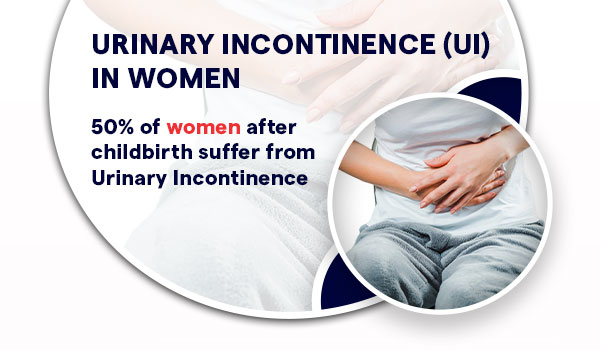More than 50% of women suffers from Urinary Incontinence Because When the baby moves down through your vagina to be born, your pelvic floor stretches and it remains stretched for some time. It often occurs when you laugh, cough, or sneeze.
Dr Ashwin Mallya Consultant, Urologist and Robotic, Uro Onco Surgeon, Sir Ganga Ram Hospital explained that It is very common to have Urinary Incontinence after child birth in women because of week muscles, While it usually goes away on its own within a few weeks, Kegel exercises can help.
But If it continues for long in Women after child birth & without child birth is the point of concern which needs to be treated.”
Let Us Understand more about Urinary Incontinence on this UI WEEK (17th June – 23rd June ).
The combination of hormones and stretched muscles means the muscles that control your bladder are weakened. This can lead to an accidental leak of urine
Urinary incontinence (UI) is the involuntary loss of bladder control, leading to the accidental leakage of urine. It is a common condition that can range from occasional minor leaks to more frequent and severe issues. This condition can affect individuals of all ages but is more prevalent among older adults, especially women.
Urinary incontinence has been around for centuries, but it's only recently that we have started talking about it openly. In India, the stigma surrounding this condition has often kept people from seeking help. However, the numbers tell a different story.
Over the past few decades, the occurrence of urinary incontinence (UI) in India has increased significantly. According to a study by the World Health Organization (WHO), there has been a noticeable rise in the number of cases reported. This increase can be attributed to a growing elderly population, lifestyle changes, and better awareness of the condition.
Urinary incontinence affects both men and women, but women are more likely to experience it. Studies show that up to 45% of women and 15% of men in India suffer from some form of urinary incontinence. This disparity is largely due to differences in anatomy, pregnancy, childbirth, and menopause, which are unique risk factors for women.
Studies show that 30-40% of women experience urinary incontinence at some point in their lives, while only 5-15% of men do. The chances of having this condition go up as people get older. For example, around 20% of women aged 20-40 have urinary incontinence, but more than 50% of women aged 80 and above do. For men, about 5% of younger men have it, and this number rises to around 30% for men over 80.
Types of UI
There are several types of urinary incontinence, each presenting differently:
Stress Incontinence: Leakage of urine during physical activities such as coughing, sneezing, or lifting heavy objects.
Urge Incontinence: A sudden, intense urge to urinate followed by involuntary leakage.
Overflow Incontinence: The bladder doesn't empty completely, leading to frequent or constant dribbling of urine.
Functional Incontinence: Physical or mental impairments prevent timely access to a toilet.
How is it effecting your organs?
Urinary incontinence doesn't just affect the bladder but it can lead to skin issues like rashes and infections due to constant moisture. Additionally, it can cause urinary tract infections (UTIs), and in severe cases, it may lead to kidney damage. The emotional toll can also be significant, leading to anxiety, depression, and social isolation. Many people may start avoiding social activities or situations where they fear embarrassment, which can lead to social isolation and a reduced quality of life.
Causes and Risk Factors
Several factors can contribute to urinary incontinence, including:
Aging- Muscle weakness and decreased bladder capacity.
Pregnancy and Childbirth- Pressure on the bladder and pelvic floor muscles.
Menopause- Decreased estrogen levels affect bladder control.
Prostate Issues- Enlarged prostate or prostate surgery in men.
Obesity- Extra weight increases pressure on the bladder.
Chronic Diseases- Diabetes and neurological disorders can interfere with bladder function.
Prevention and Lifestyle Modifications
Preventing urinary incontinence involves adopting a healthy lifestyle:
• Maintain a healthy weight as it reduces pressure on the bladder.
• Stay active by doing regular exercise strengthens pelvic floor muscles.
• Limit caffeine and alcohol as these can irritate the bladder.
• Quit smoking because smoking can lead to coughing, which exacerbates stress incontinence.
• Bladder training as it can help in delaying urination and scheduling bathroom visits can help.
Diagnosis and Treatment
If you suspect you have urinary incontinence, it's important to go see a doctor. Diagnosis typically involves:
• Check medical history and go for physical exam to identify underlying causes.
• Take urine tests to check for infections or other issues.
• Maintain a bladder diary to record fluid intake and urination patterns.
• Take specialized tests such as urodynamic tests to assess bladder function.
Treatment options vary based on the type and severity of incontinence and may include:
Pelvic Floor Exercises: To strengthen muscles around the bladder.
Medications: To reduce symptoms or address underlying conditions.
Medical Devices: Pessaries or urethral inserts for women.
Surgery: In severe cases, to provide long-term relief.
Behavioral Techniques: Bladder training and scheduled bathroom visits.
Urinary incontinence is a common condition that affects many people, particularly women. While it can be distressing, it is manageable with the right approach. Understanding the causes, seeking timely diagnosis, and making lifestyle changes can greatly improve quality of life. If you or someone you know is struggling with urinary incontinence, remember that help is available, and you don't have to face it alone.
Dr Ashwin Mallya
Consultant, Urologist and Robotic, Uro Onco Surgeon
